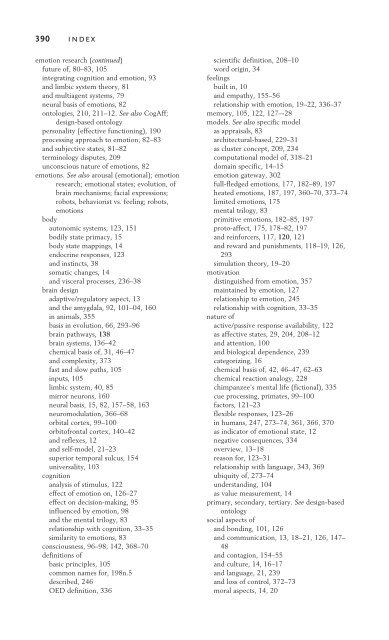Who Needs Emotions? The Brain Meets the Robot
Who Needs Emotions? The Brain Meets the Robot
Who Needs Emotions? The Brain Meets the Robot
Create successful ePaper yourself
Turn your PDF publications into a flip-book with our unique Google optimized e-Paper software.
390 index<br />
emotion research (continued)<br />
future of, 80–83, 105<br />
integrating cognition and emotion, 93<br />
and limbic system <strong>the</strong>ory, 81<br />
and multiagent systems, 79<br />
neural basis of emotions, 82<br />
ontologies, 210, 211–12. See also CogAff;<br />
design-based ontology<br />
personality (effective functioning), 190<br />
processing approach to emotion, 82–83<br />
and subjective states, 81–82<br />
terminology disputes, 209<br />
unconscious nature of emotions, 82<br />
emotions. See also arousal (emotional); emotion<br />
research; emotional states; evolution, of<br />
brain mechanisms; facial expressions;<br />
robots, behaviorist vs. feeling; robots,<br />
emotions<br />
body<br />
autonomic systems, 123, 151<br />
bodily state primacy, 15<br />
body state mappings, 14<br />
endocrine responses, 123<br />
and instincts, 38<br />
somatic changes, 14<br />
and visceral processes, 236–38<br />
brain design<br />
adaptive/regulatory aspect, 13<br />
and <strong>the</strong> amygdala, 92, 101–04, 160<br />
in animals, 355<br />
basis in evolution, 66, 293–96<br />
brain pathways, 138<br />
brain systems, 136–42<br />
chemical basis of, 31, 46–47<br />
and complexity, 373<br />
fast and slow paths, 105<br />
inputs, 105<br />
limbic system, 40, 85<br />
mirror neurons, 160<br />
neural basis, 15, 82, 157–58, 163<br />
neuromodulation, 366–68<br />
orbital cortex, 99–100<br />
orbitofrontal cortex, 140–42<br />
and reflexes, 12<br />
and self-model, 21–23<br />
superior temporal sulcus, 154<br />
universality, 103<br />
cognition<br />
analysis of stimulus, 122<br />
effect of emotion on, 126–27<br />
effect on decision-making, 95<br />
influenced by emotion, 98<br />
and <strong>the</strong> mental trilogy, 83<br />
relationship with cognition, 33–35<br />
similarity to emotions, 83<br />
consciousness, 96–98, 142, 368–70<br />
definitions of<br />
basic principles, 105<br />
common names for, 198n.5<br />
described, 246<br />
OED definition, 336<br />
scientific definition, 208–10<br />
word origin, 34<br />
feelings<br />
built in, 10<br />
and empathy, 155–56<br />
relationship with emotion, 19–22, 336–37<br />
memory, 105, 122, 127–-28<br />
models. See also specific model<br />
as appraisals, 83<br />
architectural-based, 229–31<br />
as cluster concept, 209, 234<br />
computational model of, 318–21<br />
domain specific, 14–15<br />
emotion gateway, 302<br />
full-fledged emotions, 177, 182–89, 197<br />
heated emotions, 187, 197, 360–70, 373–74<br />
limited emotions, 175<br />
mental trilogy, 83<br />
primitive emotions, 182–85, 197<br />
proto-affect, 175, 178–82, 197<br />
and reinforcers, 117, 120, 121<br />
and reward and punishments, 118–19, 126,<br />
293<br />
simulation <strong>the</strong>ory, 19–20<br />
motivation<br />
distinguished from emotion, 357<br />
maintained by emotion, 127<br />
relationship to emotion, 245<br />
relationship with cognition, 33–35<br />
nature of<br />
active/passive response availability, 122<br />
as affective states, 29, 204, 208–12<br />
and attention, 100<br />
and biological dependence, 239<br />
categorizing, 16<br />
chemical basis of, 42, 46–47, 62–63<br />
chemical reaction analogy, 228<br />
chimpanzee’s mental life (fictional), 335<br />
cue processing, primates, 99–100<br />
factors, 121–23<br />
flexible responses, 123–26<br />
in humans, 247, 273–74, 361, 366, 370<br />
as indicator of emotional state, 12<br />
negative consequences, 334<br />
overview, 13–18<br />
reason for, 123–31<br />
relationship with language, 343, 369<br />
ubiquity of, 273–74<br />
understanding, 104<br />
as value measurement, 14<br />
primary, secondary, tertiary. See design-based<br />
ontology<br />
social aspects of<br />
and bonding, 101, 126<br />
and communication, 13, 18–21, 126, 147–<br />
48<br />
and contagion, 154–55<br />
and culture, 14, 16–17<br />
and language, 21, 239<br />
and loss of control, 372–73<br />
moral aspects, 14, 20






